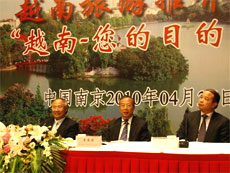 According to the Department of Travel under VNAT, the Culture, Sports and Tourism departments in HCMC, Quang Ninh, Quang Nam and Danang as well as other relevant departments are taking part in the promotion activities.
According to the Department of Travel under VNAT, the Culture, Sports and Tourism departments in HCMC, Quang Ninh, Quang Nam and Danang as well as other relevant departments are taking part in the promotion activities.
China and Vietnam have agreed to cooperate to develop tourism products and to promote tourism.
The country’s tourism sector organized a similar program in Jiangsu Province on May 3.
The events have attracted about 100 Chinese tour operators, officials and media and Chinese tour operators and media have asked about Vietnam’s tourism incentives and policies to attract tourists from the neighboring country.
The program in Jiangsu Province had positive results as the two sides
agreed to exchange familiarization trips to survey tourist attractions
and to support programs to promote destinations. In addition, they
agreed to cooperate to promote tourism on TV and in various other media
and to cooperate to train human resources, especially tour guides.
Vu The Binh, Director of Department of Travel under VNAT, said that
the administration had signed a memorandum of understanding to develop
tourism with tourism bureaus in the two provinces.
Some local and Chinese enterprises pledged that they would send tourists to each other after the promotion program.
Binh said the tourism sector would also organize a similar promotion program in Shanghai.
VNAT reported that China is the tourism sector’s biggest source
market. About 227,800 Chinese people have visited Vietnam already this
year, up 115% year-on-year.
The tourism sector has increased promotion activities in China over
the past two years to recover the number of travelers in the country.
Nearly 528,000 Chinese visitors visited Vietnam last year, still lower than the record number of 778,000 in 2004.
The tourism sector is more interested in Chinese tourists who travel
to Vietnam with passports, as they spend more than others who travel
with laissez-passer. Such travelers have ranked about 20% in total
Chinese visitors to Vietnam in the past. However, the number increased
to 50% last year.